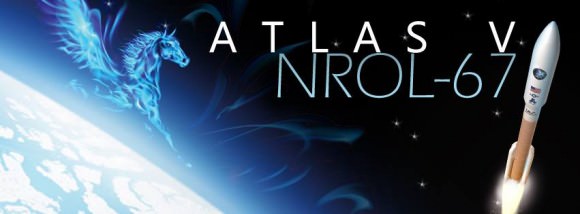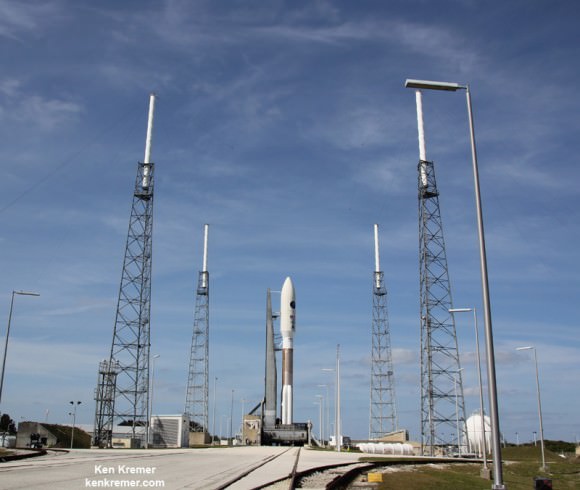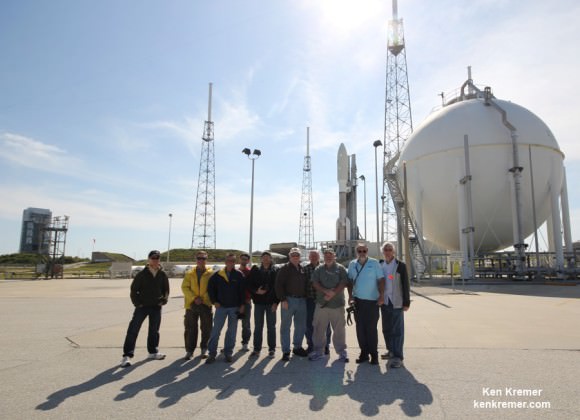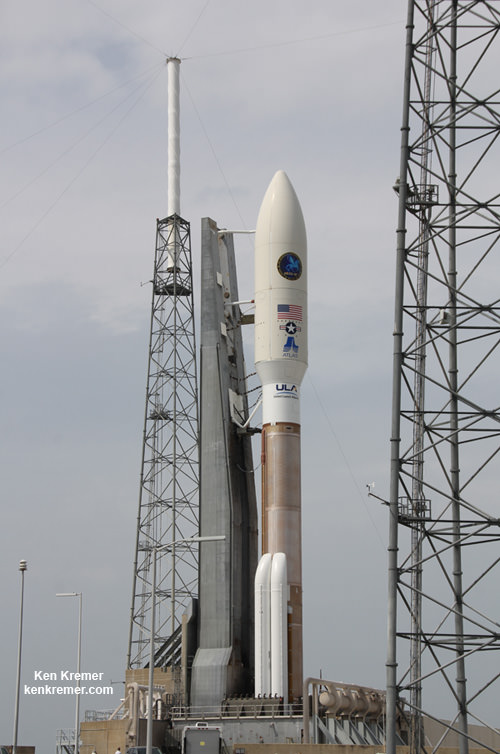CAPE CANAVERAL AIR FORCE STATION, FL – The sudden and unexpected outage of a crucial tracking radar that is mandatory to insure public safety, has forced the scrub of a pair of launches planned for this week from Cape Canaveral, FL, that are vital to US National Security, United Launch Alliance, SpaceX and NASA.
The tracking radar is an absolutely essential asset for the Eastern Range that oversees all launches from Cape Canaveral Air Force Station and the Kennedy Space Center on the Florida Space Coast.
The pair of liftoffs for the National Reconnaissance Office (NRO) and SpaceX/NASA had been slated just days apart on March 25 and March 30.
Urgent repairs are in progress.
Both launches have now been postponed for a minimum of 3 weeks, according to a statement I received from the 45th Space Wing of the US Air Force that controls the critical launch control systems, communications, computers and radar elements.
An Atlas V rocket carrying the super secret NROL-67 intelligence gathering spy satellite for the National Reconnaissance Office and a SpaceX Falcon 9 rocket carrying a Dragon cargo freightor bound for the International Space Station (ISS) were both in the midst of the final stages of intensive pre-launch processing activities this week.
The Eastern range radar was apparently knocked out by a fire on March 24, a short time after the early morning rollout of the United Launch Alliance (ULA) Atlas V rocket to the launch pad at Space Launch Complex 41 on Cape Canaveral.
“An investigation revealed a tracking radar experienced an electrical short, overheating the unit and rendering it inoperable,” according to today’s explanatory statement from the USAF 45th Space Wing.
“The outage resulted in an inability to meet minimum public safety requirements needed for flight, so the launch was postponed.”
A SpaceX spokesperson likewise confirmed to me that their launch was also on hold.

A fully functional tracking radar is an absolute requirement to ensure the success and safety of any launch.
The range radar must also be functioning perfectly in order to destroy the rocket in a split second in the event it veers off course to the nearby heavily populated areas along the Space Coast.
Myself and other space journalists had been working at Pad 41 on March 24 and setting up our remote cameras to capture spectacular up close views of the blastoff that had then been scheduled for March 25.

Insufficient maintenance and antiquated equipment due to a lack of US government funding and investment in infrastructure may be implicated.
The range outage for such an extended period of time reveals a clear vulnerability in US National Security planning.
The Air Force is also looking into the feasibility of reviving an inactive radar as a short term quick fix.
But in order to use the retired backup system, it will also have to re-validated to ensure utility and that all launch control and public safety requirements are fully met.
Simultaneously, the engineering team is recalculating launch trajectories and range requirements.
Such a revalidation process will also require an unknown period of time.
The full impact of putting these two launches on hold for the NRO and SpaceX is not known at this time.

Furthermore, the USAF will need to determine the downstream scheduling impact on the very busy manifest of all of the remaining launches throughout 2014 – averaging more than one per month.
Neither the NRO nor NASA and SpaceX have announced firm new launch dates.
The earliest possible Atlas V launch date appears to be sometime in mid-April, but that assessment can change on a dime.
In the meantime, personnel from the 45th Space Wing will continue to work diligently to repair the range radar equipment as quickly as possible.
ULA engineers also rolled the Atlas V rocket back to its processing hanger until a new launch target date is set.
SpaceX likewise awaits a target launch date for the Dragon CRS-3 cargo mission packed with some 5000 pounds of science experiments and supplies for the six man station crew.
It seems likely that the next Orbital Sciences Antares/Cygnus launch to the ISS will also have to be postponed since Dragon and Cygnus berth at the same station port.

Stay tuned here for Ken’s continuing Atlas V NROL 67, SpaceX, Orbital Sciences, commercial space, Orion, Chang’e-3, LADEE, Mars rover, MAVEN, MOM and more planetary and human spaceflight news.
Learn more at Ken’s upcoming presentations at the NEAF astro/space convention, NY on April 12/13 and at Washington Crossing State Park, NJ on April 6. Also at the Quality Inn Kennedy Space Center, Titusville, FL, March 29.


a radar outage?
that can only mean one thing. the govt is flying in tons of dope. just like the king of the city the big bad banksters and their black bag pets want to get their beak wet.
google “mena airport radar out chip tatum”
Maybe what ever caused it to happen had a REALLY really good reason…? http://blog-imgs-57-origin.fc2.com/n/o/v/november32nd/Evo5.jpg
No conspiracy theories please.. Am kind of surprised though that the Air Force or NASA doesn’t have the ability to call in an AWACS type aerial backup for just such contingencies.
Meanwhile… we must assume Space-X will pop open the Dragon capsule to replenish time critical consumables and load some fresh fruit and veggies? Maybe they will even use the time to clean up that ‘oil stain’?
I’m not sure if an AWACS radar package would be up to the task? I am fairly certain the radar suite on an Aegis guided missle destroyer should be more than capable.
Given military capabilities I find it somewhat troublesome that the military hasn’t very quickly moved such an asset into place since it’s a military spy sat that is being launched for national security reasons, read Ukraine. I fear that the real problem is that a military tracker does not conform to NASA’s 1,000 page requirements document for tracking devices. OK ,I made up the # of pages; bet I’m close
I’m afraid that NASA specsmanship which I’m familiar with will overburden and kill nascent commercial space by all the unnecessary cover your tail specifications paperwork and administrators.
The test range is run by the Air Force, not by NASA. NASA is not responsible for its operation or maintenance. Like SpaceX (and ULA), they are a customer.
I don’t know if the Air Force runs the tracking stations itself, or contracts the job out to some private company.
In either case, given how important the tracking network is, and the fact it is mostly located (both at the Cape and on various islands downrange) at sea level in a hurricane-prone area, I am very surprised they don’t seem to have lots of redundancy, spare parts on hand, and a disaster recovery plan.
Neither launch vehicles nor satellites are assembled within a matter of weeks, and it is likely that all our non-geocynchronous satellites already cover Ukraine. This launch has probably been in the works for years. That said, the lack of backup on this vital radar system is a bit surprising.
You can bet your last dollar that our eyes in the sky are keeping close tabs on Ukraine at this point. Wait a minute…… I already spent that last dollar, now what to do?
Meanwhile, am wondering what’s aboard that NRO Atlas V. The configuration is similar to what has been used to launch the presumably unmanned X-37B space plane and also large antenna ASARS (Automated Synthetic Aperture Radar System) obs. missions.
“Myself and other space journalists”
Should be: Space journalists and I.
Or: along with other journalists, I have been …
What is the seemingly obsession nowadays with the pronoun “myself”? “Me” is so much easier. I don’t necessarily mean to single out this instance — it is used everywhere!!
THANK YOU, RUF!!!!!
I thought journalists were supposed to know the language.
The tracking radar is an absolutely essential asset for the Eastern Range
=====
No, it’s not… the rockets are self-guiding and with modern inertial guidance and GPS, range radar is superflous…
Insufficient maintenance and antiquated equipment due to a lack of US government funding and investment in infrastructure may be implicated.
===
Nasa gets a $17 billion budget each year… keeps 8,500 ‘workers’ at KSC despite no Nasa rocket launches between 2011 and at least 2018… keeps 15,000 ‘workers’ at JSC for ‘astronaut support’ for only TWO American ISS astronauts..
What’s implicated is Federal Govt/Nasa waste, incompetence, pork, not lack of funding.
Tracking radar isn’t there to guide the rocket, it is there to determine the trajectory of the rocket independently of the guidance systems as these may fail causing the rocket to become a danger to people in the vicinity.
Of course, a dude/dudette could watch the rocket climb into the sky and press a button at a convenient moment if necessary. Won’t the hairy part of the ascent last for only half a minute or so and then the slow-exploding bomb is (or should be) already above the ocean?
I don’t buy into conspiracy theories, I believe what happened here is exactly as reported. However, given the system is clearly so safety critical, why was it so poorly maintained as to catch fire due to a short circuit, and why is there not double or even triple redundancy – presumably it could have failed during a launch as opposed to during the hours prior to one. Cost cutting no doubt, at the expense of public safety (of primary importance) and scientific and commercial interests (of secondary importance). If I were a US citizen, I would be demanding an answer from my congressman and from the secretary of the air force or whatever.
Honestly, I don’t get it! What a shitty organization not to have a back-up system…